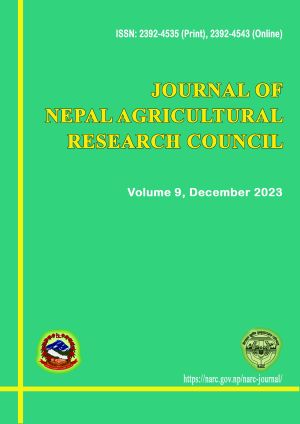Evaluation of Hot Pepper (Capsicum annuum L.) Genotypes for Yield and Quality in Mid-hills of Bagmati Province, Nepal
DOI:
https://doi.org/10.3126/jnarc.v9i1.61589Keywords:
Disease resistant, Yigh yielding genotypes, Open pollinated, Open field, Consumer preferencesAbstract
The study was carried out to evaluate and select high yielding, insect pest and disease resistant hot pepper genotypes with preferred characters at open field conditions for central mid-hills of Nepal in 2018 and 2019. Seedlings of six hot pepper genotypes AVPP9905, AVPP9813, AVPP0506, Suryamukhi, Pusa Jwala and Kantipure were transplanted on April first week at Khumaltar, Lalitpur. Crop geometry was maintained with the 60 x 60 cm in randomized complete block design with three replications and fertilized with 150:120:100 NPK kg + 20 ton FYM per hectare. Observations were recorded on vegetative growth, insect pest and disease, yield attributing parameter and response of consumers and farmers. Among the tested genotypes, AVPP9905 showed superior performance that was vigoros, earliest days to flowering (41) and fruit set (47 days), least insect damage (2.0), least disease; alternaria leaf spot (1.8 ), higher number of fruits per node (1.25), superior yield (26.19 t/ha) and 960 g per plant. Consumers and farmers preference were 4.4 and 4.5.and the maximum fruit size was 18.7 g. The second superior cultivar was AVPP0506 which showed vigor (4.0), medium days to flowering (44.3) and fruit set (49 days), less insect damage (2.2), less disease; alternaria leaf spot (2.1), higher number of fruits per node (1.3), superior yield (14.28 t/ha) and 548 g per plant, consumers (3.8) and farmers preferred (4.8). Hence it could be generalized that introduced genotypes from the world Vegetable Centre, Taiwan were more promising than local check cultivars (Pusa Jwala and Kantipure) in terms of growth, fruit yield and insect pest and disease resistance, and farmers and consumers preference. These two genotypes are recommended for cultivation in central mid-hills of Bagmati Province in open field conditions.
Downloads
Downloads
Published
How to Cite
Issue
Section
License
Copyright (c) 2023 Nepal Agricultural Research Council

This work is licensed under a Creative Commons Attribution-NonCommercial 4.0 International License.
This license enables reusers to distribute, remix, adapt, and build upon the material in any medium or format for noncommercial purposes only, and only so long as attribution is given to the creator.




